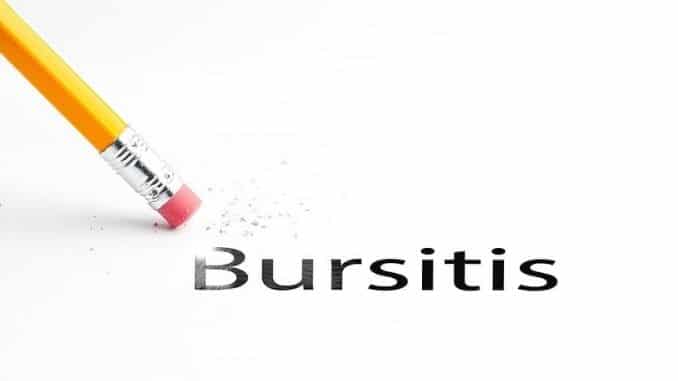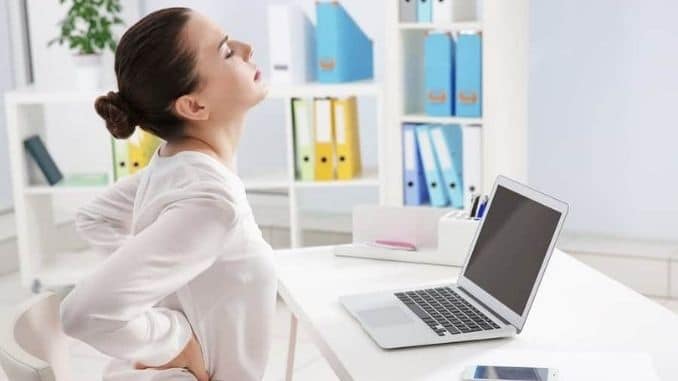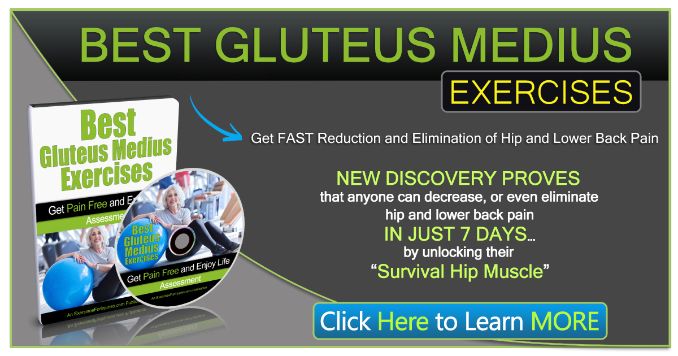
Question: Do you have any suggestions on how to deal with chronic hip bursitis? I have had issues with my left hip and a tight lower back for the past year. I have recently had a cortisone injection (into my hip), and I’m not sure what to do next.
Answer: In addition to what you are currently doing, you may also want to practice proper posture at all times. Whether you are sitting, standing up, exercising, or sleeping this can help take away extra pressure on your weight-bearing joints like your hips, spine, and neck.
Sitting in unnatural positions, which frequently occurs in modern chairs, can place the pelvis in a stressful position, causing pain. If you are standing up for a prolonged period, it is helpful to take time to rest and/or move around.
Chronic Hip Bursitis
Hip bursitis is a condition characterized by pain and discomfort as a result of the inflammation of the bursa. And this can affect the shoulder, knee, and hip where the three-dimensional movement of the joint poses an increased injury risk. The term “hip bursitis” covers pain and inflammation around the bursae of the hip. This includes the specific bursitis type trochanteric, ischial, gluteal, and iliopsoas.
Hip bursitis is incredibly uncomfortable and frustrating. It is because the hips are almost always loaded, with both walking and sitting loading the connective tissues. The posture of the hips during the day will play a large role in the development or prevention of bursitis. In this article, we’re going to take you through How to Deal with Chronic Hip Bursitis and how you can improve some of the contributing factors without medical intervention.
The Contributing Factors For Bursitis
Joint balance and the muscular demands that give rise to it are a huge part of the development of bursitis. The insertion of the femur into the hip is influenced by the muscles that attach to both. And the relationship between the two is key to causing or reducing bursitis. Excessive tightness on one side of the joint can cause friction between the ball of the femur and the bursa of the hip. This contributes to a pattern of pain that heals and returns.
Excessive joint pressure is another risk of poor or unbalanced musculature around the hip joint. The hips are considered to be the powerhouse of the body and attach to some of the largest muscles in the body, such as the glutes and quads.
The acetabulum houses several bursae, all of which are susceptible to the onset of bursitis. If sufficient care isn’t taken to balance out the muscular demands. However, there are several other contributing factors: arthritis, gout, and infection. Even obesity can contribute to damage to the acetabulum and bursae. Be sure to consult your medical professional to ensure that you are not suffering from bursitis as a result of one of these preconditions.
Posture affects both of these issues, either directly or indirectly. Posture is a direct contributor to and the result of poor muscular balance around the joint. Additionally, posture can contribute to the development of serious conditions such as arthritis that can, in turn, result in bursitis.
With the amount of time spent sitting — add up the minutes you spend driving, sitting at a desk, or sitting on the couch. There is a lot of pressure put through the hip, and we often put it into poor posture. This contributes to poor hip posture and can exaggerate the risk of inflaming the bursa.
Practical Guidelines For Dealing With Bursitis
Posture is not only one of the causes of chronic remitting bursitis. But also one of the best ways to alleviate the issue. It ensures that you’re giving your body every opportunity to heal and become well once more. Bad posture increases the risk of bursitis, but good posture will offset this risk.
Sitting posture is one of the largest contributors to the development of hip tightness, pain, and bursitis among busy professionals. If you’re struggling to fix your hip pain, there is a good chance that your seating posture is the reason why. If you’re spending 6 or more hours in a compromised position every day, you’re going to experience negative health effects. Try to keep the hips open and the lumbar spine straight while sitting. But remember that sitting for extended periods is still likely to contribute to poor hip and spine health.
If you’ve been sitting too long, standing is the next step to relieving your hips. And also reducing the stress that contributes to recurring bursitis. Standing up or walking around — even better — can decompress the hip joint and return the joint to mobility and health. Don’t forget that when you sit down, you’re taking the weight off the muscles and placing it on the bones and connective tissues, compressing the spine and hip joint.
The best thing to do is punctuate your sitting or static standing with brief walks. This is key when you’re in the office, for example, and spend a long time in a compromising position. Try setting regular alarms that force you to get up and move. Even if only to the water cooler. Or make it a habit to take a short stroll every time you achieve a small goal or task.
Fixing The Structural Issues
The two major tools available for improving the condition of bursitis. At least those forms of bursitis are caused by muscular imbalance. These are exercise and stretching or mobility. The tightness and tone of muscles around a joint are a huge factor in the positioning and health of the joint. In turn, determines your risk of developing and redeveloping bursitis.
There’s no real benefit to controlling the pain and other symptoms, such as through a cortisone shot. If you’re not taking steps to reduce the overall problem and prevent future incidences.
Consistent stretching even at your desk is an amazing tool for self-treatment of a number of the symptoms and causes of hip bursitis. Tightness through the groin or buttocks can be a serious issue. But can be resolved in the long term by relaxing the muscle through intentional stretching.
Tightness through the gluteus medius is the most common cause of bursitis. While other muscles like the quadriceps, iliopsoas, and adductors can contribute to poor hip positioning. The best approach on How to Deal with Chronic Hip Bursitis is to stretch all the muscles affecting the hips. Do this while performing functional exercises to return it to a healthy position.
Stretching is particularly important concerning the muscles of the buttocks. These play a huge role in the onset of tightness in the region and can directly contribute to bursitis. Excessive tightness through the gluteal muscles will not only directly increase pressure on the deep trochanteric bursa and others. But can increase the odds of developing a tight iliotibial band. This can cause friction against the bursa or place the hip in a compromised, or compensated, position.
How Strengthening Exercises Can Improve Your Hip Health
Once you have reduced excessive tightness, strengthening exercises play a key role in the development of proper joint balance as well as gait. If you can improve the musculature support and balance around the joint, this will improve the passive alignment of the joint, whereas improved gait, or walking posture, is a great way to alter the amount of pressure placed through the hip in everyday life.
It is common for weaknesses of the gluteus maximus (buttocks) or adductors (groin), and weakness in the antagonist, to put the hip joint into compromising positions that increase walking impact and the chance of developing impingement or bursitis.
Exercise is also a great choice for combating the kind of bursitis that develops with advanced age. As the body ages, the risk of muscular weakness and developing arthritis through degeneration increases. Adding muscle mass around a joint provides a wealth of benefits by stabilizing the joint, acting as a shock absorber against impact, increasing bone density, adjusting joint balance, and improving nutrient delivery.
Why Core Exercise Is A Great Way To Combat Bursitis
Performing core exercise can reduce the strain placed through muscles and connective structures in the hips. When the core is too weak, other muscles around the hips tend to “pick up the slack,” compensating for this instability. This can cause excessive tightness and tone in muscles like the gluteus medius, which presses on the deep trochanteric bursa — the main site for bursitis.
Closing Remarks
A self-medication approach can include a system of exercises, stretches and postural adjustments that aim to solve the causes of lower back pain while many clinical or medical interventions aim at a “bandage” approach that patches over symptoms for the short-term. If you’re looking on How to Deal with Chronic Hip Bursitis or to address the causes of back pain without medication or bandage solutions, we recommend the complete approach to solving back pain naturally.
If you want to overcome or prevent back and lower body injuries, then click here to check out the Gluteus Medius Exercises program, here!





